Virtual Reality and Augmented Reality: Transforming Healthcare Through Immersive Innovation
Virtual reality (VR) and augmented reality (AR) are revolutionizing healthcare by enhancing training, improving therapy, and elevating patient engagement. Discover how these immersive technologies are shaping the future of medical care.
3/14/20253 min read


Virtual Reality and Augmented Reality: Transforming Healthcare Through Immersive Innovation
Technology has always played a critical role in advancing healthcare, but few innovations hold the transformative potential of virtual reality (VR) and augmented reality (AR). Once reserved for gaming and entertainment, these immersive technologies are now making profound impacts in medical training, patient therapy, and engagement strategies across the healthcare landscape.
As VR and AR tools become more accessible and sophisticated, healthcare providers are discovering powerful new ways to educate, treat, and connect with patients—unlocking experiences that were once unimaginable.
Revolutionizing Medical Training with VR and AR
One of the most promising applications of VR and AR in healthcare is in medical education and training. Traditionally, hands-on experience has been limited by access to patients, cadavers, or high-fidelity simulators. VR and AR remove these barriers by creating realistic, interactive simulations that replicate human anatomy, surgical procedures, and complex medical scenarios.
With VR headsets, medical students can practice surgical techniques in a safe, controlled environment—repeating procedures as many times as needed without risk to real patients. AR overlays can provide real-time guidance during procedures, allowing trainees to visualize underlying anatomy or step-by-step instructions while working with physical models or even live patients.
This approach not only enhances technical skills but also improves confidence and decision-making. By bridging theory and practice, VR and AR are producing a new generation of clinicians who are better prepared for the complexities of modern medicine.
Enhancing Therapy Through Immersive Experiences
Beyond training, VR and AR are proving to be powerful therapeutic tools across a wide range of medical and mental health applications.
In pain management, VR has been shown to reduce discomfort by distracting patients with calming, immersive environments during painful procedures or chronic pain flare-ups. Cancer patients undergoing chemotherapy, burn victims during wound care, and individuals with phantom limb pain have all benefited from VR’s ability to shift focus and reduce perceived pain.
In mental health, VR exposure therapy is being used to treat phobias, post-traumatic stress disorder (PTSD), and anxiety disorders. By gradually exposing patients to virtual representations of feared situations in a controlled setting, therapists can guide individuals through desensitization and coping strategies more effectively.
Physical therapy is also being transformed. AR-based exercises turn rehabilitation into an engaging, game-like experience that motivates patients to complete movements while tracking progress in real time. VR balance training is helping stroke survivors regain mobility, while AR devices are guiding orthopedic patients through post-surgical recovery.
These immersive approaches not only improve treatment adherence but also make therapy more enjoyable, interactive, and personalized.
Engaging Patients Like Never Before
In addition to training and therapy, VR and AR are reshaping patient engagement and education. Healthcare providers are using 3D visualizations to explain diagnoses, procedures, and treatment plans in ways that are more understandable and memorable than traditional charts or verbal explanations.
For example, AR apps can overlay a patient’s imaging scans onto a 3D model, helping them visualize a tumor’s location or the path of a planned surgery. VR tours of hospital environments are reducing anxiety in pediatric patients by familiarizing them with the setting before their procedures.
Immersive patient education tools empower individuals to take a more active role in their care, improving health literacy, trust, and satisfaction.
The Road Ahead: Challenges and Opportunities
While the promise of VR and AR in healthcare is clear, challenges remain. Cost, integration with existing systems, user training, and clinical validation must be addressed for widespread adoption. Ensuring accessibility for smaller healthcare providers and under-resourced settings is also critical to avoid disparities in care.
Data security and patient privacy are key considerations, particularly as AR and VR solutions begin interfacing with sensitive medical records or real-time biometric data. Developers and healthcare leaders must work together to establish robust security frameworks and ethical guidelines.
Despite these hurdles, the momentum is undeniable. As hardware becomes more affordable and software platforms more versatile, VR and AR will increasingly become standard tools in the healthcare toolkit.
Conclusion: A More Immersive, Empowered Future
Virtual reality and augmented reality are doing more than adding bells and whistles to healthcare—they’re enabling deeper understanding, faster learning, more effective treatment, and stronger connections between providers and patients.
From surgical simulation and mental health therapy to patient education and physical rehabilitation, these technologies are transforming care in ways that are more immersive, interactive, and human-centered.
In the coming years, VR and AR will continue to break down barriers to access, understanding, and engagement—bringing healthcare closer to the people it serves, one immersive experience at a time.
Partner with Two Wolves Defense and Security for IT solutions you can trust. Let our veteran-led team protect your data, streamline your operations, and deliver proactive, transparent, concierge-level IT services tailored to your business needs—so you can focus on what matters most.
813-419-7227
© Copyright TWO WOLVES DEFENSE AND SECURITY. All rights reserved.

